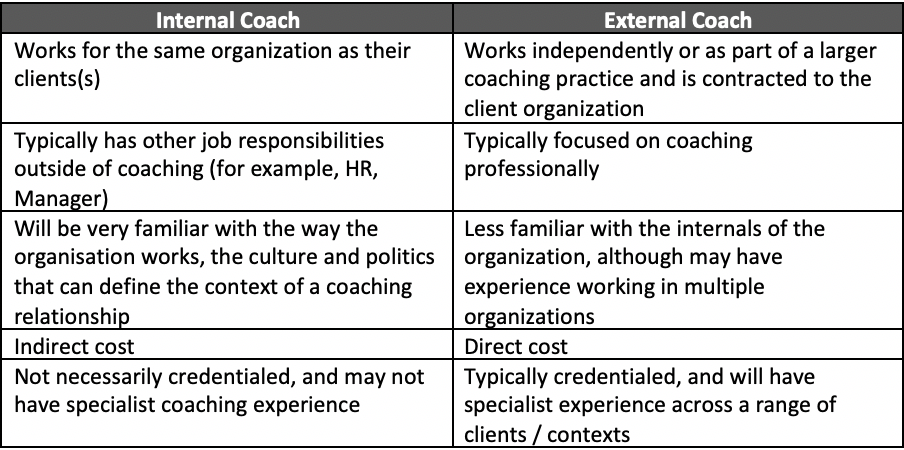
In this blog series, we’re exploring the role that coaching should play in your overall People Development strategy. Our previous post explored how to build more discipline around the coaching process and programs to ensure they are meeting the current and future needs of the business. Here we consider where to invest to maximize the ROI.
With the growing body of evidence to support the value and impact of coaching for both the individual client(s) and the organization as a whole, the question should not now be whether or not to have a deliberate coaching strategy, but rather the nature of that strategy in service to the needs of your organization (If you’re unconvinced, refer to this post)
Before we explore the relative merits of the internal vs external coach, let’s first try to objectively differentiate the two:

This is intended to reflect the ‘typical’ example in each case, and there will of course be many exceptions that contradict the table. For example, we have worked with credentialed internal coaches that are dedicated to coaching within their organizations. And, we have worked with non-credentialed part-time external coaches that have other jobs. The point is that typically Internal coaches pick up their coaching responsibilities in addition to their day jobs, and the level of investment required to get them to credentialed status is often prohibitive for many organizations. Whereas External coaches typically have very consciously chosen that path and are required to pursue credentialed status as a way to establish credibility for themselves and their practices.
With that in mind, let’s consider each approach in a few common employee development situations:
- A relatively junior employee requires some additional help meeting the performance expectations of their role;
- A high-potential employee is looking to expand their skillset in order to transition into a future leadership position;
- A senior leader has some interpersonal issues to address that are impacting their relationship with their direct reports and the culture of their extended organization.
For sake of argument, let’s assume all employees will benefit from being coached.
In the first (1) situation, the likelihood is that this is something that would typically be handled by either the employee’s manager and / or a member of the HR team. Detailed knowledge of the organization and its practices may be required, as we’re trying to get this employee back on track in their current role. Whether internal or external however, the coach should always work with the ‘whole person’, not just the corporate self that is underperforming. There may be situations and events happening outside of the work context for this employee that are impacting their ability to perform. Partnering with employee at this level still therefore requires coaching skills that would certainly need some form of formal training (which is why HR typically gets involved to support the manager).
Cost is often the primary factor which would determine whether the coach is internal or external for this case – it’s harder to justify the direct cost associated with an external coach when the ROI is limited to restoring ‘average’ performance. But remember, there is always a cost – in the case of internal employees acting as coaches, they will still need training and, when they’re coaching, there’s something else they’re not doing. With that in mind, investing in coaching skills at this level of the organization will still have an ROI. The quicker you can restore performance (or establish that it cannot be restored), the quicker the employee, team and organization will return to normal operation. And the quicker the coach can return to their primary role or move on to the next client. A lack of investment in coaching at this level will slow things down, reduce the chances of success, and carries a risk of doing further harm. Scale that up across a large organization and the cost / benefit argument is less clear cut.
The third (3) is most often the go-to for external ‘executive’ coaches. The coach would need the credibility of experience and credentials (in the eyes of the client) in order to establish an effective relationship. And the coach would need the expertise to handle the complexity of the high-achieving mind, habits and behaviors. The organization have already invested significantly in this employee (grooming them for the postition or running the executive search, forking out the executive pay and benefits and so so) so there’s a clear ROI opportunity here when just considering the executive themselves. The justification becomes even easier when balanced against the cost to the business of the executive’s part of the organization underperforming or experiencing engagement and satisfaction issues that can lead to employee stress, absenteeism and turn-over.
Unsurprisingly, given the relative maturity of the Executive Coaching field, there is data in support of ROI. For example, a study by McGovern (2001) on the impact of executive coaching shows that 43% of the companies were able to identify the return on investment of coaching. “The majority of the 43 participants . . . reported between $100,000 and $1 million as the return on investment in executive coaching,” state McGovern (p. 7).
The second (2) situation is more nuanced. As a high-potential and prospective future leader there is more of a long-term potential upside here, but the key phrase is ‘long term.’ This is about planting trees long before you need the shade. Many organizations wrestle with the challenge of investing in anything where the returns are beyond the end of the quarter, let alone years into the future. The decision maker who chooses to make the investment might not even be in the company when the returns come in. And of course, the employee themselves might choose to leave the company, taking all that investment with them (sometimes leading to ‘strings’ being attached to the investment, which is a terrible way to motivate people!).
As we discussed in a previous post, coaching is highly strategic to your organization and it therefore warrants a deliberate strategy. That will help to overcome the short-termism that can impact situation 2 (and indeed situation 1). But many organizations still struggle to determine where to invest in coaching as a strategic device.
It’s therefore case (2) which raises the most interesting questions from a strategic standpoint, so we’ll explore that in our next post.
What now?
If this article resonates with you, please share it with others.
And, if you’d like to know more about how you can unlock the potential in your High Potential employees in a safe, sustainable and scalable way, please visit www.grilledcheesecoaching.com, or join our mailing list.

